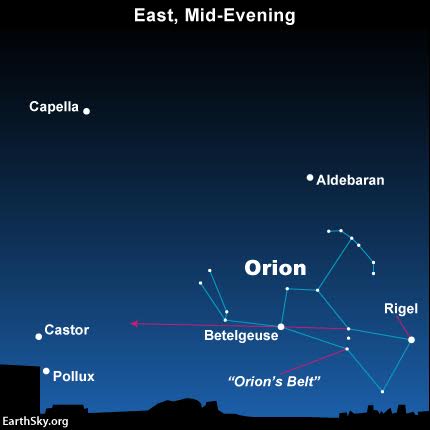
Where do you look to see December’s famous Geminid meteor shower? Simply look in an open sky, in no particular direction. That’s because these meteors fly in many different directions and in front of numerous age-old constellations. But meteor showers do have radiant points. That is, if you trace the paths of the Geminid meteors backward, they all appear to radiate from a point in the constellation Gemini the Twins. Do you need to find Gemini to watch the shower? No, but it’s fun to spot the radiant point in the night sky.
In 2018, the Geminids peak on the mornings of December 13 and 14. Here’s how to watch the Geminids in 2018.
Geminid meteors come from a point near the star Castor in Gemini. To see Castor, look fairly low in the east-northeast sky around 9 p.m. This star is noticeable for being bright and near another star of almost equal brightness – its brother star in Gemini – called Pollux. Castor is the fainter of the two Twin stars.
These stars – and the Geminid meteor shower radiant – swing upward through the night and climb pretty much overhead by around 2 a.m. That’s what’s important about a meteor shower’s radiant point: the higher the radiant rises into in your sky, the more meteors you’re likely to see.
Castor and Pollux are near on the sky’s dome to another famous and very noticeable constellation, Orion the Hunter, as shown on the charts below.
View larger. | The Geminid meteor shower radiant point ascends in the east during the evening hours (northeast from the Southern Hemisphere). Look for Castor and Pollux, 2 stars close together and of nearly equal brightness. Image via Greg Smye-Rumsby / Astronomy Now/ Royal Astronomical Society

Can you recognize Orion and the line of 3 stars known as Orion’s Belt? If, so you can star-hop to the Gemini stars Castor and Pollux. The Geminids radiate from near the star Castor.
Why do meteor showers have radiant points? Meteors in annual showers are bits of debris left behind by comets, moving in orbit around our sun. The Geminids’ parent body is a curious rock-comet called 3200 Phaethon. Remember, the meteors are arriving from outer space. They’re essentially arriving on parallel paths.
When we see them, it’s as though we’re standing in the middle of railroad tracks, gazing down the tracks and watching the tracks converge in the distance.
If you gaze along a railroad track, you see the illusion of parallel tracks converging in the distance. Like railroad tracks, meteors enter Earth’s atmosphere on parallel paths, and they appear to diverge from a single point on our sky’s dome. This is the shower’s radiant point.
Of course, the Geminid meteors don’t really come from the star Castor. The radiant nearly aligns with this star by happenstance. When Earth in its orbit crosses the orbital path of the curious rock-comet 3200 Phaethon, bits and pieces from 3200 Phaethon burn up in the Earth’s upper atmosphere. These are the Geminid meteors, which appear in our sky some 60 miles (100 km) above Earth’s surface.
The star Castor, on the other hand, lies far outside our solar system, at a distance of about 51 light-years.
According to Greek sky lore, Castor and Pollux were twin brothers, born from Leda, their mortal mother, and sired by Zeus, the immortal god. Though the brothers were united in spirit, they were divided by circumstance. Castor, the mortal, was slain in battle, leaving his immortal brother inconsolable with grief. Pollux asked Zeus to release him from immortality, so he could join his brother in the great beyond.
Today, the Gemini Twins stand together in the heavens, a testament to the redemptive power of brotherly love.

Castor and Pollux, the Twin Brothers of Greek mythology. Photo via Flickr user ketrin1407
Bottom line: You don’t need to find a meteor shower’s radiant point to see the meteors. But it’s fun to locate the radiant in the sky. This post tells you how to find the radiant point for the December Geminid meteor shower.
Click here for EarthSky’s yearly meteor guide
from EarthSky https://ift.tt/2EnbcDE

Where do you look to see December’s famous Geminid meteor shower? Simply look in an open sky, in no particular direction. That’s because these meteors fly in many different directions and in front of numerous age-old constellations. But meteor showers do have radiant points. That is, if you trace the paths of the Geminid meteors backward, they all appear to radiate from a point in the constellation Gemini the Twins. Do you need to find Gemini to watch the shower? No, but it’s fun to spot the radiant point in the night sky.
In 2018, the Geminids peak on the mornings of December 13 and 14. Here’s how to watch the Geminids in 2018.
Geminid meteors come from a point near the star Castor in Gemini. To see Castor, look fairly low in the east-northeast sky around 9 p.m. This star is noticeable for being bright and near another star of almost equal brightness – its brother star in Gemini – called Pollux. Castor is the fainter of the two Twin stars.
These stars – and the Geminid meteor shower radiant – swing upward through the night and climb pretty much overhead by around 2 a.m. That’s what’s important about a meteor shower’s radiant point: the higher the radiant rises into in your sky, the more meteors you’re likely to see.
Castor and Pollux are near on the sky’s dome to another famous and very noticeable constellation, Orion the Hunter, as shown on the charts below.
View larger. | The Geminid meteor shower radiant point ascends in the east during the evening hours (northeast from the Southern Hemisphere). Look for Castor and Pollux, 2 stars close together and of nearly equal brightness. Image via Greg Smye-Rumsby / Astronomy Now/ Royal Astronomical Society

Can you recognize Orion and the line of 3 stars known as Orion’s Belt? If, so you can star-hop to the Gemini stars Castor and Pollux. The Geminids radiate from near the star Castor.
Why do meteor showers have radiant points? Meteors in annual showers are bits of debris left behind by comets, moving in orbit around our sun. The Geminids’ parent body is a curious rock-comet called 3200 Phaethon. Remember, the meteors are arriving from outer space. They’re essentially arriving on parallel paths.
When we see them, it’s as though we’re standing in the middle of railroad tracks, gazing down the tracks and watching the tracks converge in the distance.
If you gaze along a railroad track, you see the illusion of parallel tracks converging in the distance. Like railroad tracks, meteors enter Earth’s atmosphere on parallel paths, and they appear to diverge from a single point on our sky’s dome. This is the shower’s radiant point.
Of course, the Geminid meteors don’t really come from the star Castor. The radiant nearly aligns with this star by happenstance. When Earth in its orbit crosses the orbital path of the curious rock-comet 3200 Phaethon, bits and pieces from 3200 Phaethon burn up in the Earth’s upper atmosphere. These are the Geminid meteors, which appear in our sky some 60 miles (100 km) above Earth’s surface.
The star Castor, on the other hand, lies far outside our solar system, at a distance of about 51 light-years.
According to Greek sky lore, Castor and Pollux were twin brothers, born from Leda, their mortal mother, and sired by Zeus, the immortal god. Though the brothers were united in spirit, they were divided by circumstance. Castor, the mortal, was slain in battle, leaving his immortal brother inconsolable with grief. Pollux asked Zeus to release him from immortality, so he could join his brother in the great beyond.
Today, the Gemini Twins stand together in the heavens, a testament to the redemptive power of brotherly love.

Castor and Pollux, the Twin Brothers of Greek mythology. Photo via Flickr user ketrin1407
Bottom line: You don’t need to find a meteor shower’s radiant point to see the meteors. But it’s fun to locate the radiant in the sky. This post tells you how to find the radiant point for the December Geminid meteor shower.
Click here for EarthSky’s yearly meteor guide
from EarthSky https://ift.tt/2EnbcDE

Aucun commentaire:
Enregistrer un commentaire